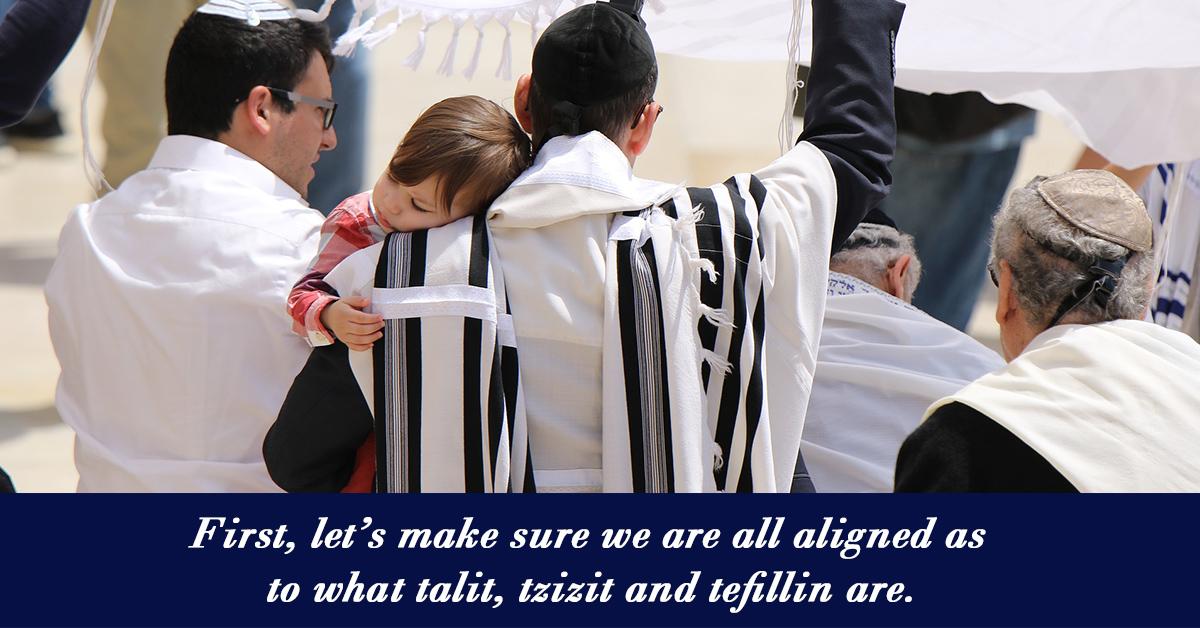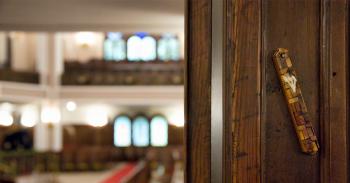
“TTT”, the name of a DJ or hip-hop song? Well, if you consider Shacharit (morning prayers) to be a form of Jewish rap, then it is in a way. TTT stands for “talit, tzizit, tefillin” representing the Triple Crown of Judaism's daily rituals. You are probably familiar with these items, their purpose and, perhaps, their biblical origins, however, you might be wondering how we went from the biblical references of “signs” and “frontlets” to big black boxes and from “tchelet” (light blue) to ornate prayer shawls, and what about those strange undergarments with strings hanging from their corners? In the following 2 part blog post we attempt to shed some light on these questions and more.
First, let’s make sure we are all aligned as to what talit, tzizit and tefillin are.
“And the LORD spoke unto Moses, saying: “Speak unto the children of Israel, and bid them that they make them throughout their generations fringes in the corners of their garments, and that they put with the fringe of each corner a thread of blue… that ye may remember and do all My commandments, and be holy unto your God.” (Numbers 15:37-40)
The Talit, a rectangular prayer shawl with fringes on each corner, and Tzizit, a shirt-like garment worn beneath clothes and also with four fringes, are both derived from these verses in Numbers. They are considered “Mitzvah Aids” (i.e. they are not considered sanctified) meant to serve as reminders of the covenant between the Jewish people and God and to symbolize one’s commitment to leading a mitzvah filled life. In addition, the practice of wrapping oneself in a talit is intended to insulate the Jewish worshiper from distractions and, according to Chazal (the Jewish Sages), the purpose of the strand of “tchelet”, which was rare and expensive to produce in biblical times, in tzitzit is to provoke pure thoughts.
“And thou shalt bind them for a sign upon thy hand, and they shall be for frontlets between thine eyes…” (Deuteronomy 6:8)
Tefillin refer to two black boxes connected to leather straps that are wrapped around the head and arm during morning prayers (different than a talit or tzitzit, tefillin are considered sanctified “Holiness Aids”). These boxes contain the 4 passages alluding to tefillin in the Torah (the word “tefillin” does not appear in the bible) inscribed on “Klaf”, special-purpose parchment. These verses, and therefore the tefillin themselves, refer to the unity of God, God’s capacity to perform miracles and God’s omnipotence in both the physical and spiritual worlds.
Indeed, there’s no mistaking these artifacts for anything else and, quite remarkably, they have more or less remained unchanged for at least 2,000 years. Prior to that, however, their original form is a bit more obscure…
Here are some more confusing facts: While the talit is the more well-known artifact, the mitzvah, as mentioned above, refers to tzitzit, without any mention of the word talit. On the other hand, the tzitzit we are familiar with today were originally called "talit katan" (small talit). OK, OK, we know this sounds more entangled then, well, tzitzit, but we will do our best to help unravel the mystery.
Let's begin with the biblical source and the mitzvah itself, which are associated with a time dated about 3,200 years ago, during Bnei Israel’s 40 years in the desert. As mentioned earlier, the verses from the book of Numbers refer to “tzitzit”, fringes that are to be attached to the corners of one's four-cornered garments, implying that such clothes (with 4 corners) were common in the region at the time. Moreover, there is evidence that garments bearing braided fringes were fashionable at the time, as a symbol of high status, as was the light blue color.
Whatever the impetus for adopting a 4 cornered garment with “tzitzit” dyed in light blue as a religious Jewish artifact, the Israelite “talit” is believed to have made it’s first appearance around 1800 BCE (roughly 3,800 years ago), 600 years earlier than the period referred to in the bible, although it was used then mostly as a burial shroud.
With time, the talit became more and more common amongst those of the Jewish faith. It was donned in prayer and some took to wearing talitot (the plural of talit) all day long. During the periods of the 1st and 2nd temples, the finer talitot were reserved for the temple priests, the Levites and the Kohanim. However, as splendid as we can imagine the talitot of the temples, dark clouds were brewing that were to change the mindset of the Jewish people to one of survival.
The destructions of each of the temples (587 BCE and 70 CE, respectively), the dispersions of the Israelites (6th and 8th centuries BCE) and, in particular, the “Annihilation Edicts” of the Roman emperor Hadrian (135 CE), caused much anxiety amongst Jews regarding wearing talitot all day long over their clothes. This led to the development of the “talit katan”, which could be worn as an under-garment, similar to today’s “tzitzit”, while the talit was worn only during prayers.
Judaic scholars have placed the advent of a talit resembling the modern day talit in the vicinity of the 2nd century CE, perhaps earlier. From that time to this very day, a period of nearly 2,000 years, although different materials, colors, designs and sizes have been applied to the talit (and to some degree, the talit katan) its form as a rectangular prayer shawl has remained constant.
One more significant fact regarding the history of the talit is its contribution to the design of the Israeli flag. As the date of the First Zionist Congress in Basel (1897) neared, the question of a flag for the Zionist movement was raised. Herzl made a proposal, but the idea put forth by another Zionist leader, David Wolffsohn, was received with all around approval, namely that the Zionists already had a flag, in the form of the talit. The movement would unfurl the talit, proudly waving it with a Magen David emblazoned in its middle. Thus, was born the foundations of Israel’s national flag.
Of course, with such a significant place in the annals of the Jewish People, we have given the talit and tzizit a place of prominence on our virtual shelves, offering a rich selection for you to choose from. Click here to visit our TTT department.
We are, however, not quite finished with our Triple Crown coverage, and invite you to come back again soon for the 2nd part of our TTT series, where we’ll delve into the depths of the black boxes of the Teffilin.



